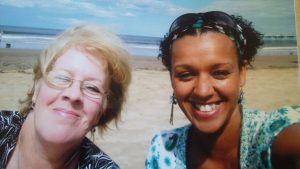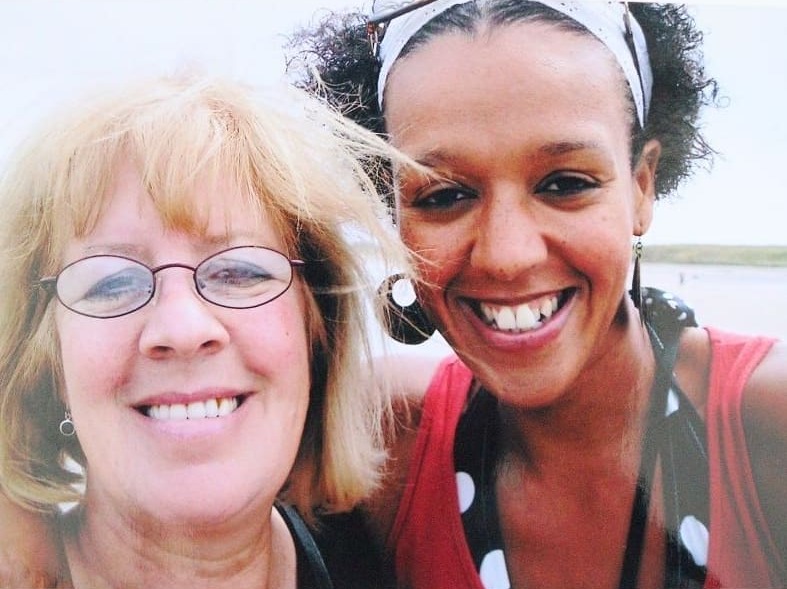by Emma Conally-Barklem
Bereavement is a messy business. It chews us up, hollows us out and folds us in two. For me, the death of my mum and best friend continues to be the most painful experience of my life. My mum was vivacious, funny, sensitive, temperamental and kind. Her energy would wear me out but in a good way, over endless cups of tea, walks, gossip and sightseeing.
We were best friends, spoke on the phone every day and enjoyed the same things. When I moved to the North Yorkshire coast, she would come for day trips to the beach. On windy days her hair would be alight with the negative ions from the sea, her smile huge and her heart gladdened at the sight of the water meeting horizon. During rare warm days, she would bound into the sea, child-like and jump the waves, laughing and waving. On cold days we would wrap up, lean into the wind and into each other, cheeks flayed red and voices carried away into the waves.

I would wave her off on the train journey, all part of the novelty and phone her immediately on her journey home. Her large eyes would watch me and find their reflection in mine, her hands holding an assortment of magazines and sweet things to nibble on the journey. My mum died of a rare stage 4 cancer in the heatwave of 2018. A part of me went with her and my life continues to shape itself around the enormity of her loss. There are days I am so angry my words get bunched in my throat and I peer out from a red mist. Other days I am numb, other days happy and dancing.
I promised I would keep her journal with the little birds on it as she is no longer able to. This has evolved into a memoir called You Can’t Hug a Butterfly: Love, Loss, Grief and Yoga. I carry my mum in my large eyes, the shape of my mouth, my sweet tooth, sensitive nature and love of books. She visits me in dreams, fashionable and happy transformed back to her former self and this is a comfort; her spirit is strong and part of the nature which surrounds me.
Without the anchor of my Yoga practice, I’m not sure where I would be. Amidst great pain, there exists great hope but this is not always apparent when you are in the throes of hurt, absence and regret.
The most prevalent narrative around grief in western society is that of the stages of grief. Swiss psychiatrist Elizabeth Kübler-Ross first introduced her five-stage grief model in her book On Death and Dying (1969). Her work was based on the study of terminally ill patients and their emotional response at the prospect of their own mortality. She identified five stages of grief: denial, anger, bargaining, depression and acceptance. These stages have come in for much criticism in recent years because of the false perception of their linear nature and chronology of the grieving process which many see as reductive. Kübler-Ross has stated since that these stages are non-linear and that people may not experience some, if any of them. Still, however, this idea of grief which is able to be packaged neatly up into boxes is an enticing and persistent one.
The stages are familiar and I’m sure most people have experienced each emotion or process in relation to their grieving process at some point – they do not, however, allow for the immensity of emotional feeling, which marks the grief experience that lays outside of language, an inarticulate knot of sorrow which evades any claim to rationality. It is here that yoga and grief intersect.
Yoga, like grief, is non-linear and stands apart from the cage of language. If yoga students are asked how they feel after a yoga class they may say ‘calm’, ‘relaxed’, ‘chilled out’ but the stillness that emanates from them and the centred, mindful way they move belies a deeper feeling. Grievers similarly may say they feel ‘sad’, ‘angry’ but scratch the surface of these somewhat anodyne descriptions and a furled heart of pain that shifts shape and cannot be boxed into stages is evident.
Yoga is a holistic 8 limb path into self-realisation and healing. Rather than pushing emotions such as anger, frustration and sadness away, we learn to sit with the feeling – allow and observe without running away. Yoga practice is a natural fit with the grieving process as it is always moving away from self-judgment and shame towards self-acceptance. Grieving within a grief-illiterate society is isolating and lonely. Unhelpful platitudes to ‘stay strong’, ‘move on’, ‘time heals’ can make the griever feel as though they are failing, that there is a time limit to grief when in fact the grief becomes a part of that person. Tears and emotional outbursts are seen as a sign of weakness when in fact such emotions are healthy indicators of the love the person had for the deceased and the necessary pain that loss means to the griever. The process is non-linear and best taken day by day.

Like yoga, the present moment is all there is and we can live that moment fully without expectation and judgement. We feel the samsaric cycle of birth and death in the birth of the inhale and the death of the exhale. Each breath is a metonym for our brief precious time here on this plane of existence. We practice ancient ways to breathe, which honour our hearts and cultivate peace whilst seeking out the resistance and aches in our bodies by either shaking them up or letting them rest and be. Practicing the ‘Wood chopper’ breath to release anger and anguish, feel the comfort of belly breathing to dispel anxiety and tension, we sit and follow the repetition of our thoughts and guide the mind gently back to the breath.
We read the poetic truth of The Upanishads, which describe death and the circle of life. We study The Yoga Sutras, which describe tersely our suffering caused by our fear of death and the loss of others. In this, we feel ourselves to be part of a continuum in the ocean of humanity, our DNA and genes invisible traces of the lost loved one threading through our everyday existence. Some days we question, bargain, rage, despair. Other days we laugh, relax, or our mind is just there. We learn to take these shifting sands of emotion in equal measure, a place beyond recrimination.
Here, we enter a vast space of all that is and all that is felt. We move beyond the efficacy and limitations of language to a place of pure awareness where the very fabric of existence compels us to feel the truth that all that was will always be.
Grief is the flipside to love and the love which connects all sentient beings is yoga.
For more information about Emma, you can check out her website.
Support us by driving awareness!
Subscribe to our YouTube channel at YouTube.com/GrapGrief.
Follow us on Facebook at Facebook.com/GrapGrief and on Instagram at Instagram.com/GrapGrief.







